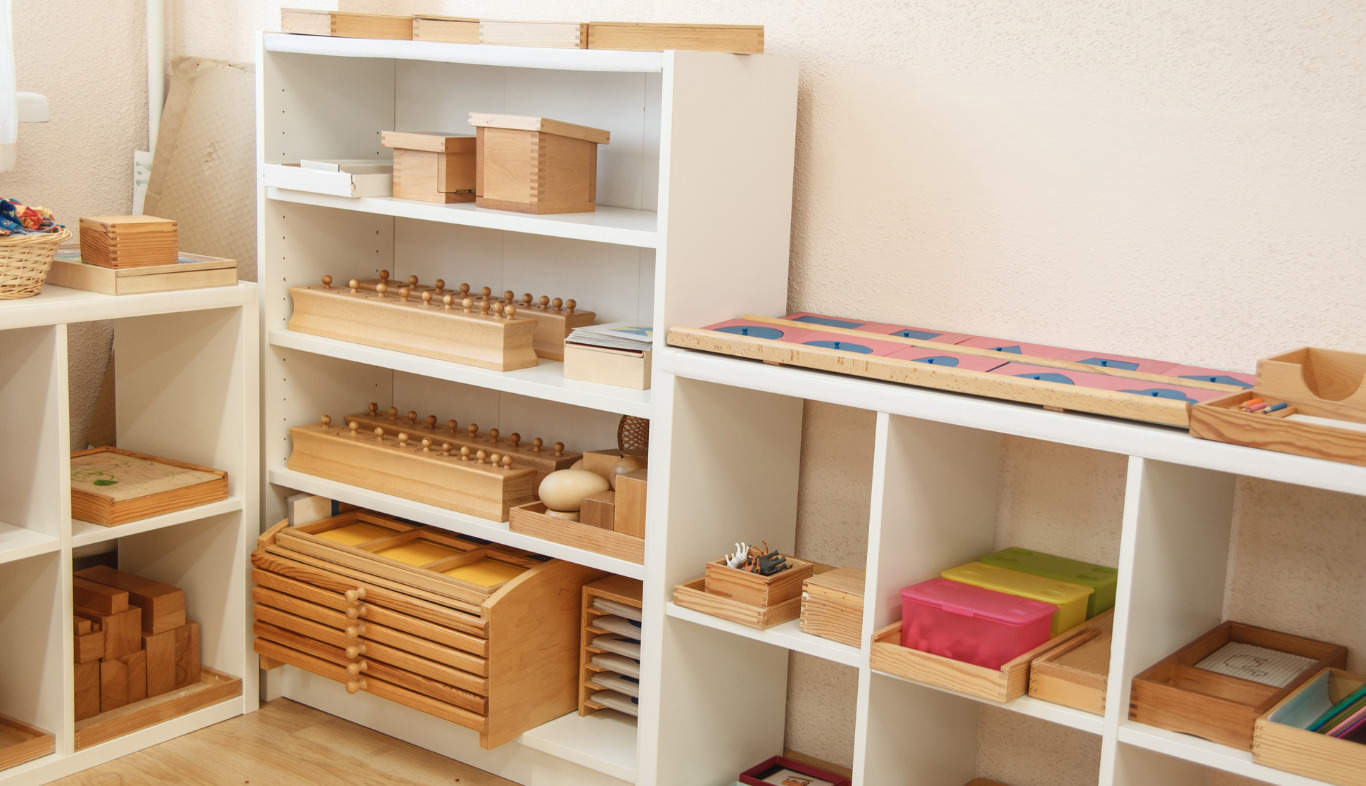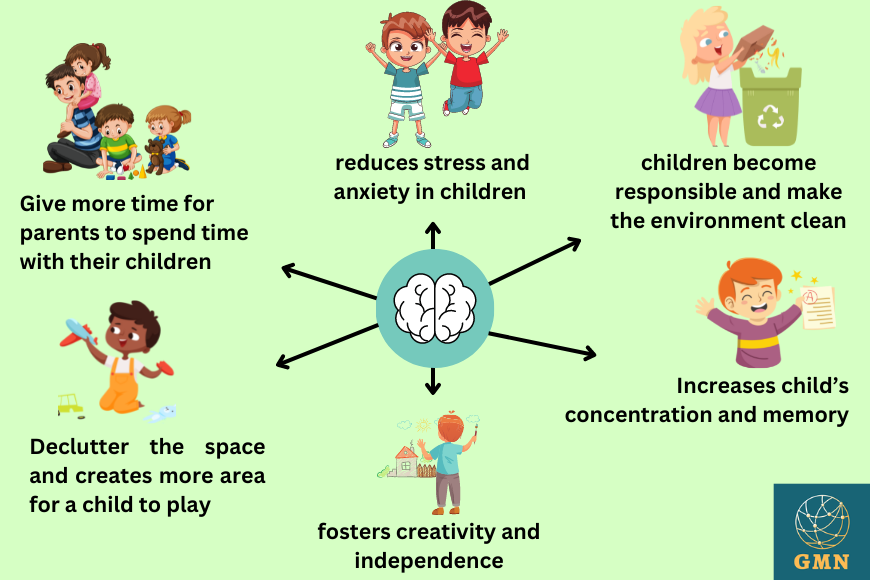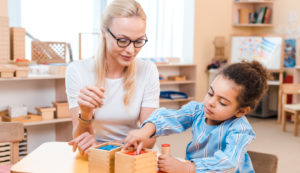A child’s engagement in play begins in infancy and benefits their development. When children play, they interact with the physical and social elements of the environment, allowing them to discover challenges and learn new skills. This enhances a child’s overall development, health, and well-being.
Sir Ken Robinson’s TED Talk, “Bring on the Learning Revolution,” presents the concept of a student-centered environment. It is much needed to provide a firm foundation in early childhood for the development of social, emotional, cognitive, and physical skills in order to encourage lifelong learning.
Children learn best when they are engaged in a variety of activities. But does it mean that we should provide them with a plethora of toys and tasks to learn with?
It is essential to understand the “what”, “why,” “when,” and “how” behind the rotation of activities and materials in Montessori schools so that you can apply it successfully at home.
What is a Toy Rotation and Why is it Important?
The concept of activity rotation refers to the provision of limited activities or toys placed on a front open shelf, which are focused on the development of a range of skills, and then replacing them with another set once that competency has been achieved. The rotation of toys can be done weekly, monthly, or seasonally depending on a child’s interest and skill achievements. It helps in decluttering the space and increasing a child’s concentration.
In an article titled, “The influence of the number of toys in the environment on toddlers’ play”, the authors explained observations from their study which indicated that when children are provided with fewer toys in the environment, they engage in longer periods of play with a focus to explore and play more creatively (Dauch et al, 2017).
The concept of activity rotation also aligns with Dr. Maria Montessori’s observation that children are benefited from a clean environment. She discovered that children in a calm, decluttered, and structured environment often engage for longer periods of time. Additionally, this improves the concentration of children and makes them more responsible and independent.
However, the concept of toy rotation is not officially derived from Maria Montessori’s research, but it does complement her findings.
“I then came to realize that everything about the child should not only be in order but that it should be proportioned to the child’s use and that interest and concentration arise specifically from the elimination of what is confusing and superfluous” by Dr. Maria Montessori in The Secret of Childhood
Montessori emphasizes minimalism, arranging fewer objects neatly on low shelves with space between them. Therefore, introducing too many toys overwhelms children, resulting in a loss of focus and interest.
Benefits of Montessori Resource Rotation
When introducing new Montessori activities, toys, or tasks to children, it is important to do it in intervals. This way, the child will not become overstimulated and will explore the new items with ease. The rotation of Montessori activities or toys allows children to keep engaged in a deeper way and spend more time exploring. It has many benefits, such as:
- It increases a child’s concentration and memory.
- It fosters creativity and independence.
- It helps children to become responsible and make the environment clean.
- It helps declutter the space and creates more area for a child to play.
- It doesn’t make children overwhelmed and reduces stress and anxiety in children.
- It provides more time for parents to spend time with their children.
When Should You Rotate the Activities for Your Child?
There is no right age to start activity rotation for your child. However, one can start toy rotation when a child starts to interact with toys on their own.
The Montessori Method focuses on letting the child lead. Therefore, introduce the child to 5-6 Montessori toys or activities at a time and observe their interest and development needs. Once the child excels in a skill or you can rotate the activities.
This toy rotation is generally recommended till the age of 6 years, which is the beginning of the second plane of development. At this point, children start developing an interest in hobbies like reading, writing, and mathematics.
How Often Should We Rotate the Activities or the Toys?
Each child has different developmental needs. A resource material that is the most attractive for one may not be liked by the other at all. Generally, in a Montessori school, a rotation of activities is done at different times for different children, depending on their developmental needs.
Educators understand the needs of every child by observation, as this allows the children to comprehend the tasks better. In the Montessori method, there is no set fixed duration when the toys need to be rotated. You can, however, rotate activities once every two weeks or once the child reaches the required skill set. Introduce children to open-ended activities or toys as it helps in fostering creativity and builds problem-solving skills.
The Montessori method offers a unique space for books and research, so along with toys, a child must be introduced to books from an early age. Once the child has mastered the knowledge in the book, it should be rotated.
Invite the children in to witness the changes once the space has been prepped. This helps in building their interest and excitement to explore and learn.
What Steps Should be Taken While Preparing For the Montessori Activities Rotation?
In the Montessori educational method, having fewer resources for a child is always better, as it is beneficial in many ways. Here are some tips and tricks to keep in mind while preparing for the resource or activity or toy rotation.
- Introduce a child to open-ended toys/ activities to start with.
- Do not introduce a child to more than 8-10 activities at a time.
- Keep the surplus activities in a closed closet or somewhere out of reach and view.
- Prepare a list of activities and sort them by categories like pretend play, gross motor, fine motor, sensory, practical life, and creative arts, etc before introducing activities and start the rotation process.
- Introduce activities that help children develop 3-4 skills at a time.
- Keep observing your children’s interests and development needs before introducing them to new activities. If not done right, you can end up in “lost interest” or “agitated behavior” or “too easy” situations.
- To build a child’s interest, introduce books and activities.
- There are no set rules–do rotate toys when it feels right based on your observation.
- Rotate activities based on festivals or events such as Halloween, Christmas, fall, spring, etc. to keep the child’s interest.
- Involve your child in the activity selection process when planning to rotate them.
For guidance on how to set up a Montessori environment at home, click here.
Final Words
The Montessori method emphasizes on promoting the concept of less is more. Therefore, it is important to introduce a child to limited activities, toys, and tasks appropriately and rotate them on a timely basis to meet the child’s development needs. If we do it too often, the child will become bored with the new toy and won’t be interested in it anymore. On the other hand, if we do not introduce them to new things frequently enough, then they will not be able to explore their environment or learn about what is around them.
Children are a bundle of surprises, and sometimes they may renew their interest in worn-out materials. They can return to the objects that an educator might feel are easy. Children pick up skills with repetition and they like discovering novel ways to play with their old favorites and that is why rotation is important.
References
- Administrator, H. (2019, August 20). Montessori at Home: The Secrets to Successful Toy Rotation | Hollis Montessori School, NH. Hollis Montessori School. https://hollismontessori.org/blog/2019/8/20/montessori-at-home-the-secrets-to-successful-toy-rotation
- Becker, J. (2014). Clutterfree with Kids: Change Your Thinking. Discover New Habits. Free Your Home. Becoming Minimalist.
- Cambre, M., & Hawkes, M. (2004). Toys, Tools & Teachers: The Challenges of Technology. R&L Education.
- Dauch, C., Imwalle, M., Ocasio, B., & Metz, A. E. (2018). The influence of the number of toys in the environment on toddlers’ play. Infant Behavior and Development, 50, 78–87. https://doi.org/10.1016/j.infbeh.2017.11.005
- Vig, M. (2020). The Holistic Guide to Decluttering: Organize and Transform Your Space, Time, and Mind. Fair Winds Press.










